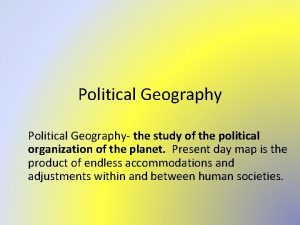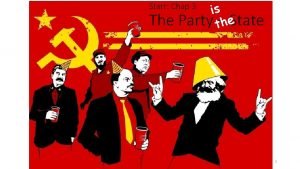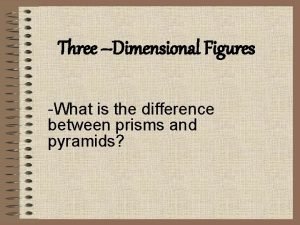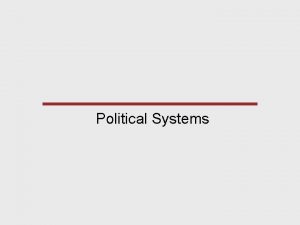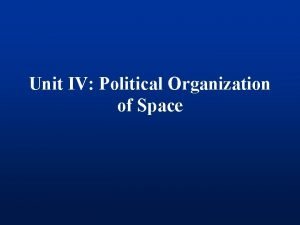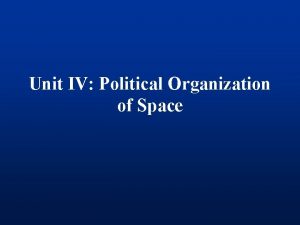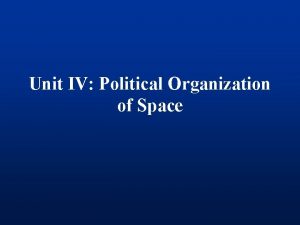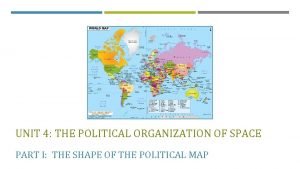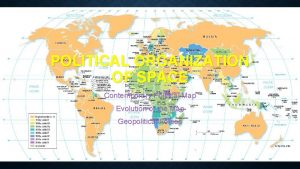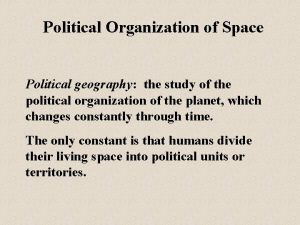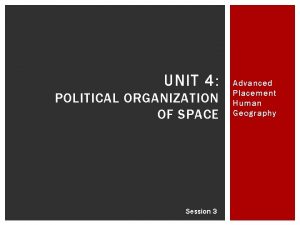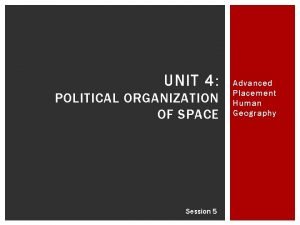UNIT 4 THE POLITICAL ORGANIZATION OF SPACE PART






























































- Slides: 62

UNIT 4: THE POLITICAL ORGANIZATION OF SPACE PART C: GLOBALIZATION


ENDURING UNDERSTANDING : (4. B) By the end of this section, you will understand that the forces of globalization challenge contemporary politicalterritorial arrangements. Recall – 1648 – the Peace (Treaty) of Westphalia made nations the norm

WHAT’S IN THIS SECTION? Here you will find out about how nations build alliances to go beyond national interests (supranationalism) How physical geography and other forces lead to devolution How centripetal and centrifugal forces are always at work, pulling and pushing nations How communications and technology affect everything.

SUPRANATIONALISM AND MULTINATIONAL ORGANIZATIONS – LARGER THAN A “STATE” Forces leading to supranationalism include economies of scale, trade agreements, military alliances and environmental issues. How do you know when supranationalism has occurred? the creation of multinational organizations. UN, NATO, EU, ASEAN, NAFTA

DEVOLUTION – THE FRAGMENTATION OF STATES Forces leading to devolution include physical geography, ethnic separatism, terrorism, economic and social problems, and irredentism. How do you know when devolution has occurred? States fragment or break apart and become Autonomous regions (Nunavut, Native American reservations) Subnational political-territorial units (Spain, Belgium, Canada) Balkanized (Yugoslavia in the Balkan peninsula, the Caucasus)

TERMINOLOGY Globalization: the integration of markets, states, communication, and trade on a world-wide scale.

TERMINOLOGY Network: A set of interconnected entities, sometimes called nodes, without a center or a hierarchy.

ESSENTIAL QUESTION How has globalization changed the way people live?

TERMINOLOGY Globalization: challenges the concept and the reality of state sovereignty.

TERMINOLOGY Globalization: change is too fast for states to keep up.

GLOBALIZATION EXAMPLE Arab Spring 2010 Anti-government demonstrations in Tunisia Spread Through social media Spread throughout North Africa and the Middle East (Southwest Asia) and lead to turmoil Contributed to immigration demands on EU.

SUPRANATIONALISM – MULTIPLE COUNTRIES JOIN TOGETHER FOR MUTUAL BENEFIT benefits Protection, trade, defense, environmental controls Costs Can come at the price of some sovereignty

SUPRANATIONALISM First modern supranationalist org was the League of Nations – after WWI. The US did not participate and the League had weak support. It did fail. The successor to the League of Nations was the United Nations, (U. N. ) created after WWII.

DO A LITTLE RESEARCH UN, NATO, EU, NAFTA Students: Find the following for each organization 1. Year began, 2. full name, 3. number of members, 4. is US a member? , 5. purpose/mission, 6. headquarters location.

ECONOMIC SUPRANATIONALISM Economics is the MOST COMMON REASON for nations to join together.

ECONOMIC SUPRANATIONALISM ASEAN (South East Asia) WTO (Trade) OPEC (Petroleum production)

ASEAN ASSOCIATION OF SOUTH EAST ASIAN NEIGHBORS ASEAN Video 3: 40 minutes By sticking with their south east Asian neighbors, ASEAN members had, collectively, the second-fastest growing economy in ASIA – well ahead of Japan, South Korea, India and Australia.

BEFORE WE GO ANY FURTHER – WHAT IS THE EU? EUROPEAN UNION FORMED IN 1993 Currency – the EURO – 1999 The EU is a Regional Trading Block Live converter: How do the Euro and the Dollar match ?

WHAT DOES A EURO LOOK LIKE?

BEFORE WE GO ANY FURTHER – WHAT IS THE EU? FAST 5 MINUTE EU VIDEO CGP GREY

WHAT DID THE SUCCESS OF THE EU INSPIRE? NAFTA North American Free Trade Agreement NAFTA • NAFTA, like the EU, is a Regional Trading Block • US, CANADA, MEXICO • 1993

MILITARY AND STRATEGIC SUPRANATIONALISM NATO – 1949 Largest military alliance in the world Mutual defense Was able to stabilize the Balkans (former Yugoslavia) in the 1990 s Kept the USSR (Russia+satellite countries) at bay. However……. After the Cold War ended, several former USSR satellite countries joined NATO. 1999 – Czechia (the Czech Republic) , Hungary and Poland. Russia angered by this – tension between NATO and Russia has increased.

SUPRANATIONALISM AND THE ENVIRONMENT Transnational corporations (see next 2 slides), to maximize profits, send work to countries of the peripheral developing world. There – environmental controls are not paramount. WHO IS TRYING TO SOLVE THIS? The UN, the world’s largest supranational organization. 1. The Food and Agriculture Organization 2. The United Nations Convention of the Law of the Sea 3. The World Meteorological Organization

TRANSNATIONAL CORPORATIONS Conduct business globally Are located - nowhere Can move when and where they like Weaken state sovereignty Create economies of scale Integrate horizontally and vertically to be more competitive

TRANSNATIONAL CORPORATIONS ↔� Integrate horizontally (health care organizations merge to control a segment of that industry. ) This reduces competition Abbott Labs merges with St. Jude Medical ↕� Integrate vertically to be more competitive Production process owned from top to bottom, increases profits Zara Clothing – owns its SUPPLY CHAIN (a network of companies around the world that produce, transport and distribute a final product. )

FORCES LEADING TO DEVOLUTION – the transfer of political power from the central government to subnational levels of government. Memorize this and be prepared to repeat it!

FORCES LEADING TO DEVOLUTION – the __________________________________________

FORCES LEADING TO DEVOLUTION – the transfer of political power from the central government to subnational levels of government. Devolution mostly follows regional lines. Memorize this and be prepared to repeat it! It will come up again!

FORCES LEADING TO DEVOLUTION What are subnational levels? This, you already know. Subnational levels can be Provincial government, regional or local governments.

FORCES LEADING TO DEVOLUTION We tend to think about nation building, as the story of the United States is about building UP from the subnational (state) level. Devolution works in the opposite direction.

FORCES LEADING TO DEVOLUTION Forces that lead to devolution are…. .

WAIT – WHAT IS DEVOLUTION AGAIN? DEVOLUTION – the __________________________________________

FORCES LEADING TO DEVOLUTION – the transfer of political power from the central government to subnational levels of government. Good!

FORCES LEADING TO DEVOLUTION So, the forces that lead to devolution are • Physical geography • Ethno-linguistic divisions • Terrorism • Economic factors • Social conditions

FORCES LEADING TO DEVOLUTION So, the forces that lead to devolution are • Physical geography • Ethno-linguistic divisions • Terrorism • Economic factors • Social conditions Of course, unitary and federal states will devolve differently.

PHYSICAL GEOGRAPHY CAN LEAD TO DEVOLUTION INDIA and CHINA and PAKISTAN all claim a stake in the Kashmir region. * *This is one of several issues along the India-China border

PHYSICAL GEOGRAPHY CAN LEAD TO DEVOLUTION

OF PHYSICAL GEOGRAPHY CAN LEAD TO DEVOLUTION? Deserts Plateaus Large Bodies of water

ETHNO-LINGUISTIC DIFFERENCES CAN LEAD TO DEVOLUTION Examples – Yugoslavia and Czechoslovakia

ETHNO-LINGUISTIC DIFFERENCES CAN LEAD TO DEVOLUTION Why not Switzerland? Well , Swiss CANTONS have a great deal of autonomy

ETHNO-LINGUISTIC DIFFERENCES CAN LEAD TO DEVOLUTION BASQUES and CATALANS In Spain must manage their desire for independence.

ETHNO-LINGUISTIC DIFFERENCES CAN LEAD TO DEVOLUTION Also The Caucasus region and Russia

FORCES LEADING TO DEVOLUTION So, the forces that lead to devolution are ü Physical geography ü Ethno-linguistic divisions • Terrorism • Economic factors • Social conditions

FORCES LEADING TO DEVOLUTION: TERRORISM Terrorism • In Spain - Basque Nationalist-separatists called the Euskadi Ta Askatasuna (ETA). They still seek independence from Spain • Globally – Al Qaeda, ISIL

FORCES LEADING TO DEVOLUTION: ECONOMICS $$$$$$$$$$$ For instance: Control of natural resources Locals might want to use resources. But: Central government might want to use resources to benefit the whole country. Examples: • North Sea oil and Scotland, • Tribal groups in the Amazon

FORCES LEADING TO DEVOLUTION: SOCIAL ISSUES

FORCES LEADING TO DEVOLUTION: BELGIUM

FORCES LEADING TO DEVOLUTION: BELGIUM

WHEN DEVOLVED POWERS GET MORE AUTONOMY . . They may seek complete independence, thus fragmenting the states. When this occurs, the state fragments along regional lines.

NOT SURPRISINGLY… This is called fragmentation

FRAGMENTATION: 3 FORMS Autonomous regions Sub-nationalism Balkanization

FRAGMENTATION: AUTONOMOUS REGIONSAutonomous regions have allegiance to the larger state; they handle day-to-day issues; comprised of a ethnic or religious minority Navajo Nation in US Jewish Autonomous Oblast in far eastern Russia Both Federal states (India) and Unitary states (China) include autonomous regions. Autonomous regions in China Video 3: 50 minutes At this time an autonomous region, China’s Xinjiang Region (how to the Uyghurs) sometimes threatens to break away into a new country, East Turkistan.

FRAGMENTATION: SUBNATIONALISM The primary allegiance of the subnation is to a traditional group or ethnicity – not the larger state. Many Quebecois feel more loyal to Quebec than they do to Canada.

Brief Video of Quebec City in the Summer! 3. 5 minutes

FRAGMENTATION: SUBNATIONALISM The primary allegiance of the subnation is to a traditional group or ethnicity – not the larger state. Other examples: North Africans in France, Russian-speakers in Ukraine and the Uyghurs in China.

FRAGMENTATION: SUBNATIONALISM The primary allegiance of the subnation is to a traditional group or ethnicity – not the larger state. Other examples: North Africans in France, Russian-speakers in Ukraine and the Uyghurs in China.

FRAGMENTATION: BALKANIZATION The breakup of Yugoslavia occurred on the Balkan Peninsula. Balkanization - 4 minutes Note – Kosovo is Not recognized as a nation by the UN, as Russia opposes it.

IMPACT OF TECHNOLOGY Three big changes: the internet, social media and jet travel Positives – Promoted globalization by connecting people Supported democratization and reform movements Negatives Weakened globalization when subnational groups organize Created a digital divide between haves and have nots Increased time-space compression

FORCES OF CHANGE Centrifugal forces – divide Centripetal forces – unite An action --- can be either; it depends For example --- an election. Can unite Can divide

CENTRIFUGAL FORCES – DIVIDE When people identify strongly with a region, as in Quebec, this can be a centrifugal force. While globalization has helped India as a whole, it has also increased economic differences. Declining state sovereignty in Syria and Iraq have given rise to Kurdish independence movements.

CENTRIPETAL FORCES – UNITE Governments do things deliberately to UNITE people. 1. 2. 3. Political identity: schools, patriotism, laws, customs Economic development: infrastructure, transportation Cultural practices in homogeneous states: Ramadan in Saudi Arabia and Pakistan Common language and restrictive immigration policies unite Japan, by maintaining a common cultu
 Political organization of space definition
Political organization of space definition Median-line principle definition ap human geography
Median-line principle definition ap human geography Nicholas spykman rimland theory
Nicholas spykman rimland theory How did darius i change persia's political organization?
How did darius i change persia's political organization? Political party organization chart
Political party organization chart Unethical political tactics and strategies
Unethical political tactics and strategies Process organization in computer organization
Process organization in computer organization Point by point arrangement
Point by point arrangement Unit 6 review questions
Unit 6 review questions Joint space vs cartesian space
Joint space vs cartesian space Space junk the space age began
Space junk the space age began Camera space to world space
Camera space to world space Unscented trajectory chapter 5
Unscented trajectory chapter 5 Ndc to screen space
Ndc to screen space Are three dimensional figures that enclose part of space
Are three dimensional figures that enclose part of space Hát kết hợp bộ gõ cơ thể
Hát kết hợp bộ gõ cơ thể Lp html
Lp html Bổ thể
Bổ thể Tỉ lệ cơ thể trẻ em
Tỉ lệ cơ thể trẻ em Gấu đi như thế nào
Gấu đi như thế nào Thang điểm glasgow
Thang điểm glasgow Alleluia hat len nguoi oi
Alleluia hat len nguoi oi Môn thể thao bắt đầu bằng chữ đua
Môn thể thao bắt đầu bằng chữ đua Thế nào là hệ số cao nhất
Thế nào là hệ số cao nhất Các châu lục và đại dương trên thế giới
Các châu lục và đại dương trên thế giới Công thức tính độ biến thiên đông lượng
Công thức tính độ biến thiên đông lượng Trời xanh đây là của chúng ta thể thơ
Trời xanh đây là của chúng ta thể thơ Mật thư tọa độ 5x5
Mật thư tọa độ 5x5 Phép trừ bù
Phép trừ bù Phản ứng thế ankan
Phản ứng thế ankan Các châu lục và đại dương trên thế giới
Các châu lục và đại dương trên thế giới Thơ thất ngôn tứ tuyệt đường luật
Thơ thất ngôn tứ tuyệt đường luật Quá trình desamine hóa có thể tạo ra
Quá trình desamine hóa có thể tạo ra Một số thể thơ truyền thống
Một số thể thơ truyền thống Cái miệng nó xinh thế chỉ nói điều hay thôi
Cái miệng nó xinh thế chỉ nói điều hay thôi Vẽ hình chiếu vuông góc của vật thể sau
Vẽ hình chiếu vuông góc của vật thể sau Thế nào là sự mỏi cơ
Thế nào là sự mỏi cơ đặc điểm cơ thể của người tối cổ
đặc điểm cơ thể của người tối cổ Ví dụ về giọng cùng tên
Ví dụ về giọng cùng tên Vẽ hình chiếu đứng bằng cạnh của vật thể
Vẽ hình chiếu đứng bằng cạnh của vật thể Vẽ hình chiếu vuông góc của vật thể sau
Vẽ hình chiếu vuông góc của vật thể sau Thẻ vin
Thẻ vin đại từ thay thế
đại từ thay thế điện thế nghỉ
điện thế nghỉ Tư thế ngồi viết
Tư thế ngồi viết Diễn thế sinh thái là
Diễn thế sinh thái là Dot
Dot Số.nguyên tố
Số.nguyên tố Tư thế ngồi viết
Tư thế ngồi viết Lời thề hippocrates
Lời thề hippocrates Thiếu nhi thế giới liên hoan
Thiếu nhi thế giới liên hoan ưu thế lai là gì
ưu thế lai là gì Hổ sinh sản vào mùa nào
Hổ sinh sản vào mùa nào Khi nào hổ con có thể sống độc lập
Khi nào hổ con có thể sống độc lập Hệ hô hấp
Hệ hô hấp Từ ngữ thể hiện lòng nhân hậu
Từ ngữ thể hiện lòng nhân hậu Thế nào là mạng điện lắp đặt kiểu nổi
Thế nào là mạng điện lắp đặt kiểu nổi Addition symbol
Addition symbol Part to part ratio definition
Part to part ratio definition Part part whole
Part part whole Technical description examples
Technical description examples Considered as the heart of the entire beverage operation
Considered as the heart of the entire beverage operation The phase of the moon you see depends on ______.
The phase of the moon you see depends on ______.


